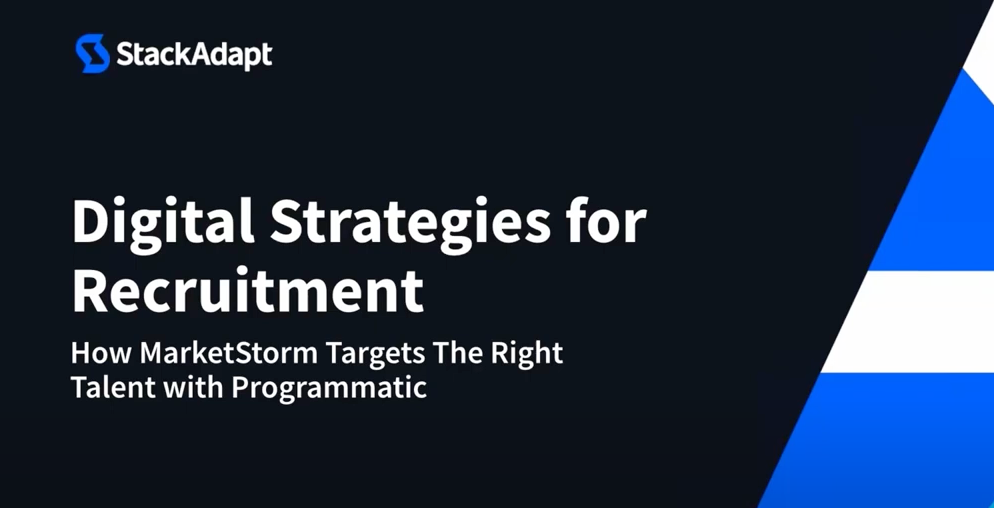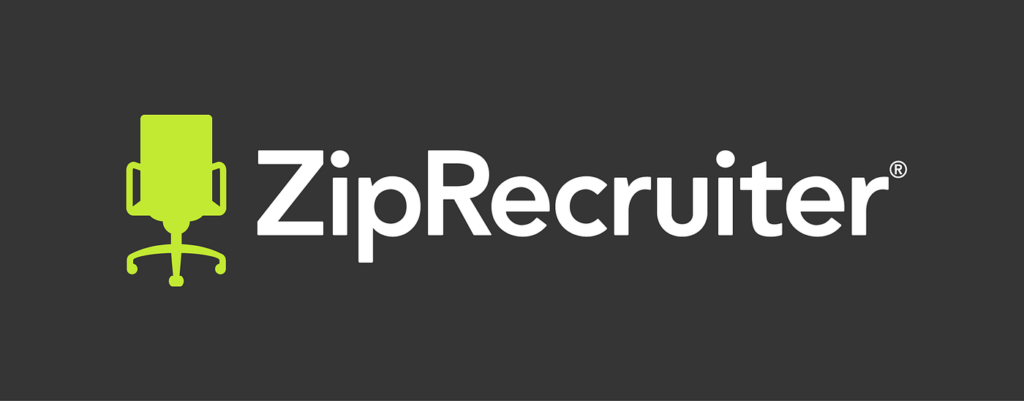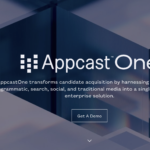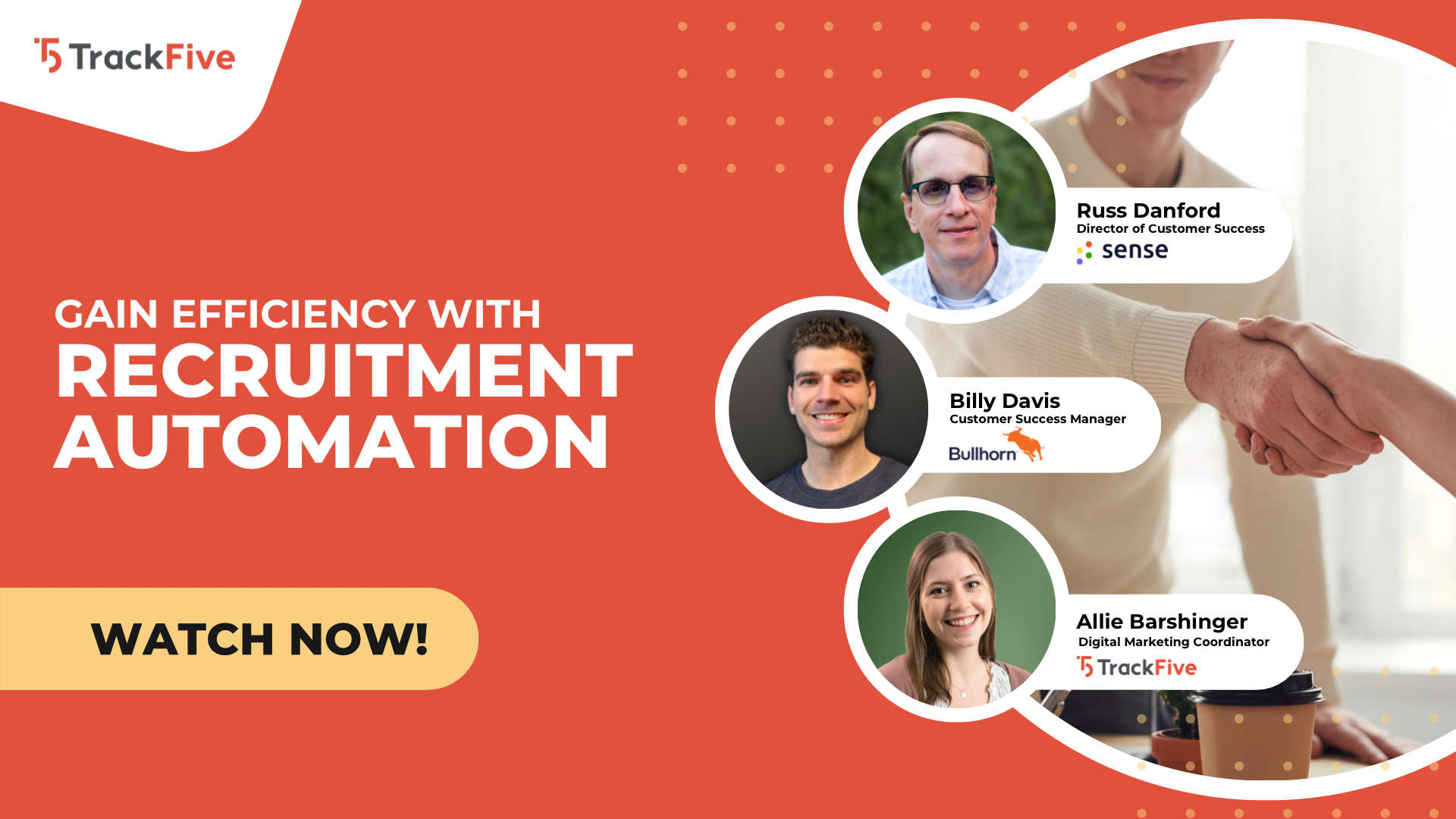Digital Strategies for Recruitment – StackAdapt

This webinar goes over what is programmatic advertising in recruitment marketing and how you can leverage this technology to target candidates and optimize spend. For those of you who havn’t heard about programmatic, it is an absolute game-changer in the talent acquisition space. There are many players jumping into this market with mixed results but the concept behind the technology is an absolute beast. This webinar goes into detail on the technology and talk about how Marketstorm helps you achieve your hiring goals.
Here is a transcript of the webinar:
Talent Acquisition Marketing- Programmatic Recruitment Strategies
Amanda:
Hello everyone, and thank you for joining us today for our webinar, Digital Strategies for Recruitment: How MarketStorm Targets the Right Talent with Programmatic. My name is Amanda Benavides and I’m part of the marketing team here at StackAdapt. Before we get started, we just have a few housekeeping items to cover, and then we can get the webinar underway. We’re happy to field any questions you have on any of the content. Please feel free to place them in the questions area of the go-to webinar panel. We will address all questions at the end of our session during the Q&A. If there are any questions we’re not able to address in the allotted time, we will follow up directly after the webinar. And just a quick note, this webinar is being recorded and will be shared shortly after we end. And with that, I’d like to hand it over to our presenters today to introduce themselves.
Andrew:
Thanks, Amanda. My name is Andrew Gluck. I am a Senior Account Manager here at StackAdapt. I’ve got about six years of experience in the programmatic space. I’ve worked on about a dozen or so different DSPs, and I’ve actually used StackAdapt for a few years even predating when I actually worked here. And it’s been amazing to see it grow. With me today is Carole Lawson, the Chief Data Officer of MarketStorm. So if you’ve joined in on this webinar, I’m guessing you already know who StackAdapt is, but just as a quick refresh, we’re a demand side platform. We started in 2013 and we’re currently offering five channels: Native, display, video, CTV, and audio. And our focus is to deliver some of the most cutting edge technology, great UI, some really cool machine learning algorithms and a great customer experience. And that is why you guys can always reach out to an account manager like myself or your account executive for anything you may need. And with me today is Carole Lawson.
Carole:
Hi there. Just like most of you, MarketStorm is a marketing agency and we work across a broad spectrum of verticals from luxury products like fine wine to entertainment, but mostly we focus on the home services area. And again, I’m Carole Lawson. I am the Chief Data Officer of MarketStorm as well as one of the founding partners. But what’s more important for this conversation today is I am a data scientist. And so why does that matter? Well, data tells a story, and the story that’s unfolding around recruiting is not just interesting from a research perspective, but it’s really market altering. We’re going to talk about that and we’re going to cover the why, the what and the how of recruiting in this new environment.
Andrew:
So a quick overview of our agenda today. First we’re going to understand the American labor shortage. Then we’re going to look into what marketers can do to address hiring. We’re going to follow it up with the tactics that we use in programmatic, and then we’re going to have a wrap up in Q&A at the very end.
Carole:
So understanding the labor shortage is really important to knowing how to address it. We all know that this is an unprecedented situation, but understanding the why—why it exists—will help us understand the tactics we can use to overcome it. As we’re having this conversation, as I was doing the research, what’s really clear is that housing and employment are intertwined from an emotional and a cultural perspective. And from a data science perspective, watching how these data points interact with each other can tell us a lot about what’s going on culturally, what’s going on in the minds of people, why things are happening. So even though we’re going to be talking about recruiting, the story really begins with housing. So the first thing I want you to notice is the Orange home value line and the blue jobs line. There’s two pieces to this here. Let’s take a look at the left hand side to start with. Economics would tell us that when jobs are lost, people can’t pay mortgages, and home prices suffer. And indeed, we saw that through the recession of 2008 through 2011. What’s really interesting is that the home values dropped by deeper percentage than the job losses. But then when you go over to the other side and you’re looking at our current reality, what you’re seeing that is instead of there being a drop off, the home prices rose. And so we’re going to talk about what’s going on with that. This relationship between the home prices and the jobs is showing us that people are in a different kind of state of mind. Financial choices now are driven less by the rules of economics than they are by this feeling of fight or flight that we find ourselves in.
Andrew:
People, they’re realizing that they can’t control everything around them, but they can control where they live. So changing where they live, that’s what’s driving up these prices and it’s an effort for them to reboot their lives.
Carole:
Yeah, exactly. That whole thinking about rebooting their life is predominant in what we’re talking about. So what we’re seeing is, nearly two thirds of US workers are looking for new jobs. We see the same response in many parts of the employment sector. So it’s not like it’s just one type of job or this type of job, but people are quitting their jobs in record numbers. What it means is that, if you have a company of a hundred, 60 to 70 of them are thinking about a new job now. 60 to 70 out of a hundred employees are thinking about a new job. So we’re looking at how the job openings have skyrocketed since 2021. And these are job openings. And so you see, during the great recession, the job losses were there and everything dropped, and that’s the gray band in the middle; jobs continued to climb, and then there’s this big bump that comes in at 2021 and going into ’22 where the pandemic changed all the rules of life. So what’s really astonishing is that there’s a 4% of the workforce that quit their job at any one month. Putting that into the context of our hundred-employee company, that means you just lost four employees this month, and if your company size is a thousand, you lost 40. Pretty significant. So how do we know that this is fight or flight related? When people are experiencing fight or flight, they do what they can to get away from the situation that they’re not feeling right or safe in. One of my colleagues put it this way: What we’re seeing is a panic attack on a national level. The outcome of this, as you know, is it’s creating a horrendous situation for employers. There’s a limited supply of qualified workers. There’s fierce competition for them. What we’re doing, generally speaking, as a whole, is trying to ramp up what we’ve always done. It must be about the money. So we’re offering huge bonuses. We’re dropping job requirements. People are investing millions of dollars into jobs platforms, trying to get the machine running the way it used to run. And it’s not going to. We’re all missing the point here. It’s not about the companies offering more, it’s about people feeling like they matter. They’ve got some control over their lives. If you’re going to compete with workers, you’re going to need to understand what exactly it is you’re competing against.
Andrew:
And just to reiterate that, we’re not talking about competing against other companies; we’re talking about competing against this cultural shift. Here you can see some screenshots from one of the most popular communities on Reddit. It’s called Antiwork. And what we’re noticing with a lot of these is that people are complaining about their situations. They’re not happy with their place in capitalism. That’s not to be political by any means. That’s just where people’s minds are at, and it’s not just a few people. What we’ve noticed is that since January of 2020, this community of about 80,000 people has ballooned to 1.14 million. There’s over 20,000 comments per day over this last quarter, and that’s top 10 across all of Reddit. Now, the way Reddit works is when we’re talking about these subscribers, these users—those are the people that have said I want to be part of this community. That’s not the limit of the number of people that are actually seeing this content. Anyone can go into this community and see what people are saying. And because it’s such a popular community, its content gets driven up to the top of Reddit. So we’re talking about basically anyone who uses Reddit is exposed to some of this messaging. And what we’re seeing here is, on the left side, some of the top posts that have been made; and on the right side, some of the most common keywords. Now what you’ll notice here is that some of it is about pay. People are still interested in pay; the economy is a bit of a mess right now, so that’s something that’s top of people’s mind, but a lot of it is actually—even more of it is about how people feel. We see keywords like overworking, toiling, layoffs, livable situations, cubicles. It’s really this kind of feeling that people have that they associate with work that isn’t great. So savvy employers understand that retention comes from happy employees and that’s great. That is what we should be doing. But in terms of actually finding new people, we need to share how we’re helping people feel fulfilled in their lives.
Carole:
So what can marketers do about this? Actually there’s a lot we can do. Thankfully there’s a lot we can do. First we need to understand that the tactics we are using in the past are going to fail. So basically, write all those up on a whiteboard, put a big box around it and say, don’t do this. Most people are not thinking, “I want to work for company X, and if I could just get a job with them,” which is a complete dynamic change. The employers are not in control anymore. It used to be that an employer could post a job, and this job was like a reward and people would compete for it, and then one person would be rewarded and they got the job. That’s not the dynamic right now. What we need to do is reach out in a way, and with a message that’s relevant to the types of employees that we want to have. So, believe it or not, these are ads for plumbers. Plumbers. And the reason why this works, I’m going to get into it in a little bit, but what we did is we spent time with the company and talked to them about what their team is like; not what their job qualifications are, not what their pay scale was—what’s your team like? What’s the perfect fit? How do we find somebody who fits those characteristics? And so people work on motorcycles, people who like to be outdoorsy. Motocross racing is one of the things that’s big with their crew. And so they’re really good people, but they’re all kind of edgy and they have this outdoor kind of vibe, the self-sufficient kind of vibe. So we created ads that speak to the vibe, that speak to who the people are, rather than to who the job is. We found that, programmatic, makes this kind of messaging, to the right kind of audience, at the right time, possible.
Andrew:
So we’re going to go more in depth into the tactics that we can use for recruiting campaigns. But at the top level, we’re using real-time bidding and machine learning algorithms to help serve ads based on human behavior. We can use our technology to create audiences. We can deliver messages in the right context where people are most receptive. We can reach candidates across all five of those channels that I mentioned earlier. And I think most importantly, we can filter candidates before they even apply. We can look for people that match the company’s culture and ensure that only those people are seeing the ads. And that way, once somebody actually gets to the interview stage, you know what you care about as their qualifications, not so much who they are. It really helps save your time; you don’t want to meet with a person who you can tell in the first 10 minutes isn’t going to be a fit. It saves their time, it saves your time, and it just ensures a much smoother and happier transition.
Carole:
So we found such success in this, that 100% of our recruiting is programmatic, and 100% of that is on the StackAdapt platform. StackAdapt is unique among DSPs because of the versatility of the platform and the strength of the team. As you’re going to see, we’ve taken normal quotes, normal tactics and flipped them sideways, or done something completely different, or come at it from a different approach. And I’ve yet to come up with any wild ideas that Andrew and the team of StackAdapt has not been able to implement. And I got to tell you, that’s saying something. So how did this work? What we’re looking at is actual data from our plumbing campaign. And I thought it was important to show what was going on in the first week, and to give you some context. Our budget is the same budget as was given to a competitor, and that competitor is using Google Ads, and that competitor is using job boards and doing all the normal tactics. They started a couple weeks before us and they got to a point where they got up to 15 page views on the employment page with no applications coming in. Within the first three days of our campaign, we had 612 page views on the employment site. 451 were identified specifically from our campaign. 32 of those moved on and went to the application pages—either the contact form or the application itself, or the training program. So this is really astounding. What we got within the first three days was a 5% conversion rate, and it stayed consistent since then.
Andrew:
So let’s look into what made this campaign and others like it a success. First up, we’ve got behavioral targeting. Now, when we talk about behavioral targeting, we’re talking about audiences that reflect human activity online. So as you browse the internet, your actions get tracked by third party data companies, as well as StackAdapt—we build our own audiences too, and we categorize people into different buckets, which we can then target. And Carole can talk a little bit about what we did exactly in this campaign.
Carole:
Yeah, so one of the ways that we use the behavioral targeting is, again, like I was talking about, working with our client to identify the culture and the behaviors of their team. We want somebody to walk in the door of that company for their interview, see people around them that look like them, that have the vibe that they have so they immediately feel like this is their place. We went through: What kind of things does your team do on their time off? What interests do they have? What books do they read? We ask just this whole list of questions, and then we build audiences and campaigns around those things first; not job seekers first, but those things first. Then we overlaid the job seekers on top of that and created an intersection. And I know that Andrew can go into a little bit more detail about how this works, but what we ended up with is this really tight group of people with the characteristics we’re looking for, who are looking for jobs.
Andrew:
Yeah, so on the technical side of how this all works, you can actually see on the right hand side of your screen, the three different bubbles. Carole talked about A and B. So we sourced a third party job seekers audience, and then for circle B there, we used just different interests and intent and affinity audiences, and we combined them into one large all-encompassing audience. Then what we did is we took that all-encompassing audience and we intersected it against that job seekers audience so that we had this targeted but still scalable audience that we could access. Now if you have specific employment requirements, you could add in a third audience as another intersection just to narrow it down even further. One thing I will say is, if you do too many intersections, you start to run out of scale. So this’ll depend on how big an audience you’re wanting to reach. But we did see that it worked great with A and B in Carole’s case, and that’s because this client did have their own training program. And if your audience and geographic area is wide enough, you could do the three-way intersection. Up next we’ve got contextual targeting. So this refers to targeting users while they’re ingesting content that is relevant. So we’ve got a number of methods to do this. We’ve got site lists, category targeting, keyword lists—and those are actually pretty standard; we do see that across a number of DSPs, but where StackAdapt comes in is we’ve got our patent-pending Page Context AI, and Page Context AI is pretty unique from keyword targeting. It does take a small list of keywords. You can start with three, scale it up to 20 in-context and 20 out-of-context keywords. But essentially what it does is it scans through these words and it understands what intent we’re trying to get across, what the general meaning is, what the context is; and then we scan all of the pages that we have access to, to find the ones that match. And this gives us a really different way of targeting people. You don’t have to have this thousand-word long keyword list like you do for search but you still get these hyper-relevant ad placements. So Carole, do you want to talk about how this worked?
Carole:
Yeah, so first of all, I want to say that as a data scientist who specializes in natural language processing, this Page Context AI is absolute brain candy. It allows me to think differently about how we’re going to target because it’s so much more powerful than just throwing out a bunch of keywords and getting this more static feeling list. This list is really alive, and it goes back to what I was saying before that we started with: “behavioral things” first, “who are the right team members” first. And even though we can’t take people looking for employment audiences and use that in this particular situation, what we wanted to do is make sure that we got our ads in front of all the right kinds of people, even if they weren’t looking for a job right now. The thinking behind this is that so many unemployed people are not searching for jobs, but they know they need to work. And so we’re seeding our audience by meeting people in their happy place.
Andrew:
Yeah, so Carole actually touched on something very important there. Page Context side does not work with our traditional audience targeting; it is kind of standalone in that regard. But that’s okay because even though it is a contextual targeting strategy, it operates almost like an audience where, again, you are getting these hyper-relevant placements. Our other methods do actually allow us to layer on audiences as well. So if you do have a site list, a category list or keyword list, you can use that audience that we talked about on the previous slide and make sure it’s running on relevant content. You can also exclude content you don’t like, and it’s very useful for that. But why this is important is, as I alluded to earlier, people are at the most receptive when they’re reading content that is in line with your ad. So we want to make sure we’re getting in front of them during that time. So that makes this a very powerful tool in that regard. The other very important thing is we are noticing that more and more browsers are putting in do-not-track features and having them on by default. That’s bringing us to what’s being called the death of the cookie or the cookie apocalypse. That is rather dramatic, but cookie audiences are going to be less relevant and contextual type targeting is going to be more important. So the fact that we have this new natural language processing AI powered tool is great and it’s really going to help you as we move forward. Next up, we’ve got geo-radius targeting. So when we talk about geo-radius targeting, there’s really two different strategies that we’re employing here. One is—we can call it geofence: So targeting people while they’re within a specific area. And the other is location audience: So this is people who have been to a specific location and then left; their device data is saved on our servers so that we know we can target them after the fact. And we can also add on different hours to say, somebody’s been to a workplace, they’ve gone home, we know we can target them during home hours away from the office. We’ve got a really cool use case that Carole here, I’ll let her take it over.
Carole:
So this goes back to being able to do different and kind of creative things. And so let me set up the scenario here. We have a heating and air conditioning company. They are opening up a new yard, and the yard is where the shop is and some office workers; but primarily it’s where the techs go to pick up their trucks and their tools and their parts and all that stuff to be ready for their day; they have the morning meetings there, all those sort of things. The way the town is laid out is that the most of the people who work in this industry live on the far north side of town. Most of the industrial areas where the yards are on the south side of town. And this commute is 45 minutes to an hour, but can be up to an hour and a half with traffic. So one of the complaints about the people who work in this industry is the commute and having to get down into this industrial area. Well, our client wanted to grab all of those employees of their competitors who hated the commute, who lived up on the north side of town. So we thought: “How are we going to do that?” Well so the first thing we do is we target all the yards that are in the industrial area, the south side of town, and collect all of the employees of our competitors. And then as that was going on, I did some research about traffic patterns and discovered that there’s only one major interchange that you have to go through in order to get from one side to another. And so we targeted that interchange and we collected the people whose traffic went across that interchange heading to the south side. And then we did an overlay of that. So we did an intersection between our first target of all the competitors and then our second target of all of the people who traveled there, and came up with an audience that worked great.
Andrew:
And so the reason this type of data is so important, it works so well is, essentially we’re taking real world activities—not just your online activities—and pulling them into the digital realm. It’s also worth knowing that this data is basically as fresh as you want it to be. If you’re using a geo-radius and capturing the people while they’re inside their workplace, that’s live, that’s when they’re there—they can see the ads. If you’re using a location audience that can be updated constantly, you can have that constantly pulling in your data, or you can narrow down to specific times: Only from nine to five? Do I want to collect people that have been through these job sites? What we do wind up seeing here is that because we can hone in on different locations, we can say if a person is repeatedly coming to this location, we can guess that they actually work there. So now we are understanding that this person is an employee and they do match the types of job requirements that we’re looking for our other jobs. This works not just in recruiting campaigns, it works in all kinds of campaigns. Auto dealers, for example. If somebody’s visiting multiple auto dealerships, you can guess that they’ve got a high intention to purchase and they’re going to do it soon. Works the same way here. The other really cool thing we can do here is, as Carole mentioned, understanding people’s commute time. So you can look at people that are currently going to job sites near yours and understand that they’re comfortable with that commute at least, and then they’ll be receptive to working for you, or you can go a bit more aggressive and look for people that live near you, but work far away. And then you’re really driving home that idea that: “You don’t have to travel an hour every day to and from work, you can get that time back.” And that’s something that people, as you saw earlier, are really interested in. They want that work-life balance, and this gives you the opportunity to provide that to them. Finally, we’ve got our first party data. So first party data is data that you or your client has generated or sourced. We’ve got three main uses here. We’ve got CRM lists, retargeting, and lookalike audiences. CRM lists are easy to upload to our platform. You just need an Excel file—actually a CSV—with their emails or their addresses, and you upload that through a LiveRamp integration and you can target them right away. And Carole’s actually got a very interesting use case here, and we’re going to circle back that in a bit. Next up, we’ve got retargeting. So retargeting is done by placing one or more of our pixels on your site or your client site. In this case, you could drop a pixel on the careers page and another pixel on the thank-you page once they’ve submitted their resume, or on the button click that takes them to an external job board. And then what you do is you build a list of everyone who’s visited your careers page and then you remove everyone who has actually gone on and converted and submitted their application. And this gives you a group of people that you can reach out to again and again. In retail and e-commerce campaigns, we do that with people who’ve added things to a cart and not checked out; that’s your cart audience. I don’t have a fancy name for it here, but it works the same way. And then finally, we’ve got lookalike audiences. These use a seed audience, be it CRM or retargeting, and it looks for the similar traits amongst all the people in that audience, and then it looks out on the internet and finds other users who match these traits, and then we can target that audience. And what’s important about this is that we can find people that we didn’t think to target with any of our other strategies. But statistically speaking, they match the people that we’re interested in and then we target them basically the same way we did with our other strategies. Carole, do you want to talk about that CRM use case?
Carole:
Yeah. So when you’re thinking about recruiting, you’re going to say, as an employer, “I don’t have CRM. I mean, if I had a CRM of all the right people, I would just go directly to them.” Well, there are places where you can find lists of the right kind of people, whether it’s an association or some other kind of group. And in this one case, we have a plumbing company in a particular state where you have to be licensed in order to work as a plumber, and so he needed to reach out to all the licensed plumbers. Went to the state website, and there was a place where you could enter in the name of a plumber and it would tell you whether or not they were licensed. So I thought, well, there’s data there. So we put in a public records request for all the data of all the licensed plumbers. We used that as our CRM, uploaded into LiveRamp and created the audience. That was, again, a very successful audience; very specific and very successful in this campaign.
Andrew:
So first party audience. First party audiences are generally at the bottom of a funnel. We have kind of distilled down everything we’ve done up until this point into a group of the most relevant users. And as I mentioned earlier, we want to kind of turn these people back onto the employment page to kind of keep our job offering top of mind for them. And that’s kind of something important to look at—is that full funnel approach. So here we have it. All the strategies that I talked about fall onto this funnel. The audience and contextual strategies are kind of at the top here. They cast that very wide net. And because they’re catching up wide net, you can serve all types of ads to them. You’ve got the full scope of what StackAdapt can bring, and we actually encourage you to use every single one of these channels, because again, you want to get as much reach as possible up here to drive people down. Looking at these actual tactics, connected TV and audio kind of stand out from the rest, in that, they’re not generally going to give you a click to your website. What they will do though is create this halo effect where people learn about your job and then look it up. And if that’s not quite enough, what you can do is also add in a retargeting pixel at a hundred percent completion point of these ad units. So once somebody has actually watched this video, they get into a retargeting pool that you can funnel people down to and keep bringing them back in. And that way, you do get that click through one of our ads. In the middle of this funnel, we see our geofencing. This one is a tactic that I would generally recommend you narrow down to display and native because we do have that tighter audience pool—but there are actual use cases for the other three channels. So just to kind of play out a scenario here: If somebody’s in an office that they don’t like—going back to that fight or flight response we talked about earlier, they’re going to want to isolate themselves from the rest of the office. And one of the easiest ways to do that while still being physically present is to pop in some earbuds and listen to some music or a podcast. If we can serve an ad to them about an employment opportunity that’s even better than the one they’re currently in, that’s very powerful; that’s something that’ll catch their attention and something they don’t think about. Again, they’re not going to click on anything. They’re going to keep working, but now they’re engaged and they’re going to come back and look for us. Likewise, if somebody’s had a rough day at the office, they get back home, one of the first things they’re probably going to do, maybe they’re going to make dinner, get changed into their home clothes, but then they’re going to probably be on the couch and they’re going to kind of try and relax, recover. And one of the ways many people do that is they stream content and that’s going to be video and connected TV. So if you bring up the idea that there’s a better place for them to work, with those tactics, again, that’s going to be very powerful; that’s going to resonate with them.
Carole:
So we have a client—and we have more than one client, but this particular client does TikTok videos that are hilarious; they’re hilarious. One of the things that we did to encourage people to begin to want to work for him is we use these very funny TikTok videos to get in front of people, just to make them smile and laugh. These are laugh-out-loud videos, and it’s just to create an affection for a plumber. I mean, you think about plumbers and you’re not: “They’re great, man. We love them”, but that’s kind of the vibe that this plumbing company wanted to create, and we thought we needed to get that in front of potential employees too. And that’s also proven to be pretty successful.
Andrew:
Yeah, and I’ve seen these videos too. They’re hilarious. If you all start looking at plumbing roles, maybe you’ll get a hit of these ads. They’re really funny and they have worked great. Before we get to the bottom of the funnel, there’s one more tactic we didn’t really talk about directly. It sits somewhere between the geo-targeting and the CRM lists. And what this is IP targeting. So right now a lot of people are working from home, so targeting people at their workplace isn’t as doable, although people are going back to work. But what many people are doing is using a VPN to tunnel into their work networks. So when they do that, their IP address reflects that work network and now you can start serving them ads, if you do have the range of IPs that the organization uses. There are places to find these lists, and if you’re clever like Carole, you’ll know where to find them. And they really do work. Finally, we’ve got the first party and CRM lists we talked about. And here, you do want to stick to native and display. The whole strategy down at this level is just efficiency, bringing people back to the site and repeating the messaging until they do convert. So we would stick with native and display here. Now we talked about five different creative types, and not everyone’s going to have all that, and that’s okay. We can actually help produce some of these for you. I’d suggest reaching out to your account manager if you’re interested and asking about the Creative Studio team that we have. It’s a value added resource, there’s no additional costs, and they do fantastic work. Alright, so just to wrap up, lots of people are currently looking for a job, they’re not settling for just about anything, and there’s fierce competition. Marketers need to meet people where they are, where they’re advertising these jobs. It’s not simply enough to say “Hi, we’re hiring.” It’s to say, “Hi, we’re hiring and we match what you’re looking for. You’ll feel at home if you come work for us.” And programmatic advertising really helps you with that by using a full funnel approach that we just went over. We do have an infographic that goes over some of these details. It is available in the resources panel of this webinar. It’ll also be emailed out after. And that’s it.
Amanda:
Yeah. So thank you so much Andrew and Carole for that fantastic presentation. So I’d like to jump into the Q&A portion of the webinar. And as a quick reminder, if you have any questions, please place them in the questions box. So it does look like we have some coming through now, so let’s tackle some here. “So you mentioned uploading CRM contact lists. With StackAdapt, how big do audience sizes need to be for targeting?”
Andrew:
So the absolute bare minimum for that would be a hundred, but we really do not recommend using that. The minimum recommended audience size would be a thousand. And if you want to use things like lookalike targeting based off that CRM list, you’ll want to have even more than that—maybe somewhere around 4,000, because there will be a drop off in the match rates.
Amanda:
Perfect. And another question related to that is: “How did you request all plumbers with a license for CRM list, again?”
Carole:
What I did is I made a public records request. You’ll have to take a look at—every state’s got little different requirements; take a look at wherever they have a list of something and that agency should tell you or have information about how to make a public records request. If not, just send them an email. There’s usually an email there and they’ll let you know. It’s really pretty easy.
Amanda:
Okay. Next question here: “What channel did you find is the best performing for recruitment campaigns? Did you have a preference when setting up the plumbing ads?”
Carole:
Yeah, and so we started with native; we’ve done some other ads also with display, but I find that the native tend to be the most effective. And then we use the display and the video for the additional tactics around to kind of bring people down into the funnel.
Amanda:
Great. We have a few more questions here. “Do you have any advice for first time clients that are hesitant to start recruiting using programmatic?”
Carole:
Yeah. The conversation that we had with our clients was, “Look, what you’re doing isn’t working and we need to reach people where they are; and so the way that we want to do that is through programmatic.” And we also didn’t say, “Stop everything you’re doing, we’re just doing programmatic.” We’re running side by side in this particular plumbing campaign with all of the traditional stuff. But it was just, “Look, we need to add this line too.” Made it a little easier. And there was some hesitation when they first saw the ads. It’s like, “Wow, these are really different, but we trust you, so go ahead.” But it’s working out quite well.
Amanda:
Amazing. Next question here is, “Does StackAdapt offer job board inventory?”
Andrew:
That will likely depend from job board to job board. We don’t offer the actual job placements, but if they do have some kind of native assets or ad slots within that list, that is something we might be able to target. You would need to reach out to your account manager and we can talk with our inventory team to see what we’ve got available.
Amanda:
Perfect. Thanks Andrew. We have a couple more questions here before we wrap up. “How detailed can you get with geo-radius targeting? Would you be able to target a specific office building, for example?”
Andrew:
So we can get fairly detailed. I wouldn’t recommend targeting an office building in a very dense area. That’s because you’re likely going to have the surrounding buildings also getting included in your radius. And we can’t target based on altitude. An office building is usually going to have multiple companies from different industries, so you’re going to get a lot of mix there. I would point you back to the IP targeting that we mentioned earlier. And I feel like the radius targeting really sees its best use case in kind of wider open areas. So an auto dealership’s great, the stockyards in suburbs would work; general office campuses or university campuses where you’ve got more of that room and less of that noise would definitely be the best use cases.
Amanda:
All right. And last question for today: “With Page Context AI, are you able to select specific domains for ads to appear on?”
Andrew:
So when you do go through that Page Context AI workflow, you’ll see some pages pop up underneath, kind of giving you a sample of where the ads may serve. That in itself isn’t a guarantee that you’ll serve on those pages. And you don’t select the ones you want. If you see pages pop up that you’re not really a fan of, you can put in some negative or out-of-context keywords to remove those and really refine your search. But the main idea of PCAI is to let the computer or let the machine learning algorithms figure out where your ads should go. You can apply inclusion and exclusion lists, but it really performs the best when it’s got the full range of inventory available to it.
Amanda:
All right. Well, thank you so much Andrew and Carole. And with that, it concludes today’s webinar and we’d like to thank you all for attending today. So we hope you found it both informative and insightful. Please don’t hesitate to reach out with any other questions you may have. Thanks again for joining us everyone, and enjoy the rest of your day.











